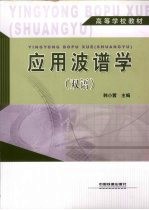图书介绍
应用波谱学:双语2025|PDF|Epub|mobi|kindle电子书版本百度云盘下载

- 韩小茜主编 著
- 出版社: 北京:中国铁道出版社
- ISBN:9787113089252
- 出版时间:2008
- 标注页数:246页
- 文件大小:37MB
- 文件页数:256页
- 主题词:波谱分析-双语教学-高等学校-教材
PDF下载
下载说明
应用波谱学:双语PDF格式电子书版下载
下载的文件为RAR压缩包。需要使用解压软件进行解压得到PDF格式图书。建议使用BT下载工具Free Download Manager进行下载,简称FDM(免费,没有广告,支持多平台)。本站资源全部打包为BT种子。所以需要使用专业的BT下载软件进行下载。如BitComet qBittorrent uTorrent等BT下载工具。迅雷目前由于本站不是热门资源。不推荐使用!后期资源热门了。安装了迅雷也可以迅雷进行下载!
(文件页数 要大于 标注页数,上中下等多册电子书除外)
注意:本站所有压缩包均有解压码: 点击下载压缩包解压工具
图书目录
Chapter 1 Ultraviolet and Visible Spectroscopy1
1.1 Introduction1
1.2 The Principles of Ultraviolet and Visible Spectroscopy4
1.3 Electronic Transitions and Chromophore11
1.4 Solvent Effects13
1.5 Empirical Rules for Absorption Wavelengths of Conjugated Systems14
1.6 Applications of UV Spectroscopy in Organic Structure Determination28
Problems30
New Words and Expressions33
第1章 紫外可见光谱法36
1.1 概述36
1.2 紫外可见光谱原理37
1.3 电子跃迁与生色团39
1.4 溶剂效应41
1.5 共轭体系吸收波长的经验规则42
1.6 紫外可见光谱在有机化合物结构测定中的应用42
Chapter 2 Infrared Spectroscopy43
2.1 Introduction43
2.2 Instrument and IR Samples43
2.3 Theory of Infrared Spectroscopy46
2.4 Infrared Spectra of Different Organic Compounds55
2.5 Interpreting IR Spectra69
Problems78
New Words and Expressions87
第2章 红外吸收光谱法90
2.1 概述90
2.2 红外光谱仪和红外样品处理90
2.3 红外光谱的基本原理91
2.4 各类有机化合物的红外光谱95
2.5 红外吸收光谱法的应用96
Chapter 3 Nuclear Magnetic Resonance Spectroscopy98
3.1 Nuclear Spin States98
3.2 Nuclear Magnetic Moments99
3.3 The Chemical Shift and Shielding101
3.4 The Nuclear Magnetic Resonance Spectrometer104
3.5 Chemical Equivalence-A Brief Overview104
3.6 Integrals and Integration106
3.7 The Chemical Environment and the Chemical Shift107
3.8 Local Diamagnetic Shielding108
3.9 Magnetic Anisotropy111
3.10 Spin-spin Splitting(n+1)Rule113
3.11 The Coupling Constant117
3.12 The Second-order Spectra118
3.13 Aromatic Compounds119
3.14 Interpretation of 1H NMR Spectra122
3.15 Carbon-13 Nuclear Magnetic Resonance Spectroscopy124
3.16 A Deeper Look:Calculation of 13C Chemical Shifts130
Problems137
New Words and Expressions145
第3章 核磁共振波谱147
3.1 核磁共振的基本原理147
3.2 影响化学位移的因素148
3.3 自旋偶合及自旋裂分150
3.4 氢核磁共振谱图及其提供的信息153
3.5 核磁共振波谱仪155
3.6 碳-13的核磁共振波谱155
Chapter 4 Mass Spectrometry158
4.1 Introduction158
4.2 Ionization Techniques159
4.3 Determination of the Molecular Formula by Mass Spectrometry168
4.4 The Mass Spectra of Organic Compounds175
4.5 Interpretation to Mass Spectrometry211
4.6 Interpretation of Four Spectra for the Identification of Organic Compounds217
Problems224
New Words and Expressions230
第4章 质谱233
4.1 概述233
4.2 质谱分析的基本原理和质谱仪233
4.3 质谱确定分子式234
4.4 各类有机化合物的质谱235
4.5 质谱解析237
4.6 四谱的应用237
Answers to Problems238
Bibliography246
热门推荐
- 17208.html
- 2871307.html
- 386702.html
- 2075494.html
- 809150.html
- 1608922.html
- 2502086.html
- 13167.html
- 230731.html
- 189460.html
- http://www.ickdjs.cc/book_1319278.html
- http://www.ickdjs.cc/book_1544928.html
- http://www.ickdjs.cc/book_40369.html
- http://www.ickdjs.cc/book_749795.html
- http://www.ickdjs.cc/book_3078209.html
- http://www.ickdjs.cc/book_1029790.html
- http://www.ickdjs.cc/book_1103077.html
- http://www.ickdjs.cc/book_94345.html
- http://www.ickdjs.cc/book_916365.html
- http://www.ickdjs.cc/book_2237530.html